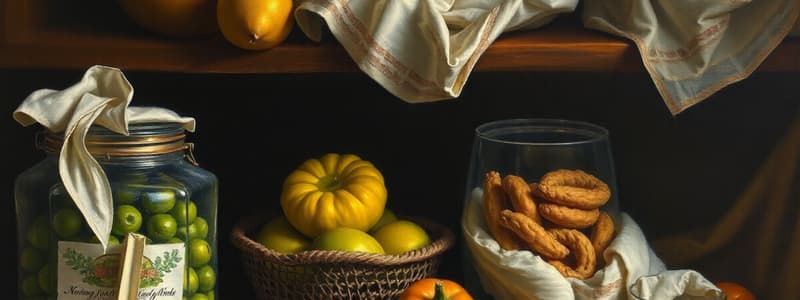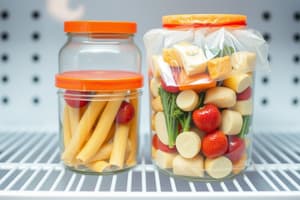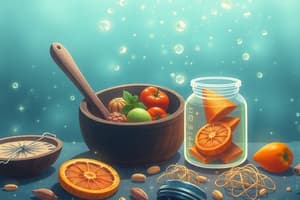Podcast
Questions and Answers
According to the Spanish Food Code, what fundamentally defines an altered food?
According to the Spanish Food Code, what fundamentally defines an altered food?
- A food that undergoes changes in its organoleptic properties, chemical composition, or nutritional value, impairing its suitability for consumption due to unintended causes. (correct)
- A food that has been deliberately modified to enhance its nutritional value.
- A food that has exceeded its expiration date but remains safe to eat.
- A food that has been preserved using artificial additives.
Which of the following factors is NOT identified as influencing the preservation of food?
Which of the following factors is NOT identified as influencing the preservation of food?
- Environmental factors.
- Physical factors.
- Chemical factors.
- Spiritual factors. (correct)
What defines the 'shelf life' of a food product?
What defines the 'shelf life' of a food product?
- The period during which the food's packaging remains intact.
- The period during which the food remains the cheapest to sell.
- The time between manufacture and when significant changes occur. (correct)
- The duration for which a food can be stored regardless of quality changes.
Which characteristic primarily defines 'perishable foods'?
Which characteristic primarily defines 'perishable foods'?
What is the typical shelf life of semi-perishable foods?
What is the typical shelf life of semi-perishable foods?
Which of the following is a characteristic of non-perishable foods?
Which of the following is a characteristic of non-perishable foods?
Which factor is classified as intrinsic in food preservation?
Which factor is classified as intrinsic in food preservation?
What classifies a factor as 'extrinsic' in the context of food preservation?
What classifies a factor as 'extrinsic' in the context of food preservation?
In food preservation, what do 'implicit factors' refer to?
In food preservation, what do 'implicit factors' refer to?
Why is hygiene particularly important in the food reception area?
Why is hygiene particularly important in the food reception area?
What is the primary purpose of the food storage area according to the text?
What is the primary purpose of the food storage area according to the text?
What temperature range is recommended for storing dry goods and canned foods?
What temperature range is recommended for storing dry goods and canned foods?
What is the recommended temperature range for refrigeration to prevent food from freezing?
What is the recommended temperature range for refrigeration to prevent food from freezing?
Why is it important to avoid interrupting the cold chain in food preservation?
Why is it important to avoid interrupting the cold chain in food preservation?
What is the main purpose of food preservation by refrigeration?
What is the main purpose of food preservation by refrigeration?
What is the primary characteristic of food preservation through freezing?
What is the primary characteristic of food preservation through freezing?
What distinguishes 'slow freezing' from other freezing methods?
What distinguishes 'slow freezing' from other freezing methods?
What is the primary objective of heat conservation methods like sterilization?
What is the primary objective of heat conservation methods like sterilization?
UHT processing, commonly used for liquids, involves what specific treatment?
UHT processing, commonly used for liquids, involves what specific treatment?
What is the main purpose of blanching as a method of food preservation?
What is the main purpose of blanching as a method of food preservation?
What is the key principle behind pasteurization?
What is the key principle behind pasteurization?
How does reducing water activity help in food preservation?
How does reducing water activity help in food preservation?
What process is involved in food dehydration?
What process is involved in food dehydration?
In food concentration methods, what does evaporation involve?
In food concentration methods, what does evaporation involve?
What is the primary mechanism of preservation in lyophilization (freeze-drying)?
What is the primary mechanism of preservation in lyophilization (freeze-drying)?
What is a key limitation of using irradiation for food preservation?
What is a key limitation of using irradiation for food preservation?
Which form of irradiation has the greatest penetration capacity in food?
Which form of irradiation has the greatest penetration capacity in food?
In chemical food preservation, what is the main role of preservatives?
In chemical food preservation, what is the main role of preservatives?
What role do sulfur derivatives play in food preservation?
What role do sulfur derivatives play in food preservation?
What is the main effect of adding salts (salting) in food preservation?
What is the main effect of adding salts (salting) in food preservation?
What is the purpose of curing meat in preservation?
What is the purpose of curing meat in preservation?
What is the preservation mechanism of smoking?
What is the preservation mechanism of smoking?
How does acidification contribute to food preservation?
How does acidification contribute to food preservation?
What is the process of marinating in terms of food preservation?
What is the process of marinating in terms of food preservation?
What is likely to result from a lack of temperature control during food storage?
What is likely to result from a lack of temperature control during food storage?
What is the primary effect of light exposure on food products regarding food preservation?
What is the primary effect of light exposure on food products regarding food preservation?
What is the impact of metallized paper in food packaging for breakfast items?
What is the impact of metallized paper in food packaging for breakfast items?
What effect does temperature have on the food preservation?
What effect does temperature have on the food preservation?
What role does a proper package and or label play in the food preservation process?
What role does a proper package and or label play in the food preservation process?
What is a result stemming from poorly chose and designated food packaging?
What is a result stemming from poorly chose and designated food packaging?
What is one of the best materials used in food preservation?
What is one of the best materials used in food preservation?
Flashcards
Altered food
Altered food
Food that, during any stage, suffers changes in its characteristics, composition or nutritional value, diminishing its fitness for consumption.
Conserved food
Conserved food
Food that has been treated to maintain hygienic conditions for a variable time.
Food's shelf life
Food's shelf life
Time between manufacturing & significant changes.
Perishable foods
Perishable foods
Signup and view all the flashcards
Semi-perishable foods
Semi-perishable foods
Signup and view all the flashcards
Non-perishable foods
Non-perishable foods
Signup and view all the flashcards
Intrinsic factors
Intrinsic factors
Signup and view all the flashcards
Extrinsic factors
Extrinsic factors
Signup and view all the flashcards
Implicit factors
Implicit factors
Signup and view all the flashcards
Reception zone
Reception zone
Signup and view all the flashcards
Storage zone
Storage zone
Signup and view all the flashcards
Refrigeration Chambers
Refrigeration Chambers
Signup and view all the flashcards
Freezer Chambers
Freezer Chambers
Signup and view all the flashcards
Food Preservation Methods
Food Preservation Methods
Signup and view all the flashcards
Cold Preservation
Cold Preservation
Signup and view all the flashcards
Refrigeration preservation
Refrigeration preservation
Signup and view all the flashcards
Freezing preservation
Freezing preservation
Signup and view all the flashcards
Slow freezing
Slow freezing
Signup and view all the flashcards
Medium freezing
Medium freezing
Signup and view all the flashcards
Rapid freezing
Rapid freezing
Signup and view all the flashcards
Heat Preservation
Heat Preservation
Signup and view all the flashcards
Sterilization
Sterilization
Signup and view all the flashcards
Blanching
Blanching
Signup and view all the flashcards
Pasteurization
Pasteurization
Signup and view all the flashcards
Decreasing Water Activity
Decreasing Water Activity
Signup and view all the flashcards
Desiccation
Desiccation
Signup and view all the flashcards
Dehydration
Dehydration
Signup and view all the flashcards
Concentration
Concentration
Signup and view all the flashcards
Reverse osmosis
Reverse osmosis
Signup and view all the flashcards
Azeotropic Dehydration
Azeotropic Dehydration
Signup and view all the flashcards
Lyophilization
Lyophilization
Signup and view all the flashcards
Radiation Preservation
Radiation Preservation
Signup and view all the flashcards
Chemical methods of food preservation
Chemical methods of food preservation
Signup and view all the flashcards
Methods without organoleptic modification
Methods without organoleptic modification
Signup and view all the flashcards
Methods w/ organoleptic modification
Methods w/ organoleptic modification
Signup and view all the flashcards
Smoking
Smoking
Signup and view all the flashcards
Acidification
Acidification
Signup and view all the flashcards
Modification of foods during storage
Modification of foods during storage
Signup and view all the flashcards
Permeation of food
Permeation of food
Signup and view all the flashcards
Sorption
Sorption
Signup and view all the flashcards
Study Notes
Food Preservation
- Food preservation is crucial for human sustenance
- Understanding food preservation methods, their origins, and influencing factors is important
Definition of Altered Food
- According to the Spanish Food Code, altered food undergoes unintentional changes during sourcing, preparation, handling, transport, storage, or possession
- These changes affect organoleptic properties, chemical composition, or nutritional value, diminishing or nullifying its suitability for consumption while remaining harmless
Factors Influencing Food Preservation
- Conserving food depends on physical, chemical, environmental, and cultural factors
- Preserved food has undergone suitable treatments to maintain hygienic-sanitary conditions for a variable period
Shelf Life
- Shelf life refers to the duration between manufacture and significant changes in a product
Variation in Food Preservation
- Food preservation can be limited and dependent on: food nature, production, storage duration, microbiological, sensory, or physicochemical changes, and packaging
- These factors may affect a food shelf life
Food Classification by Alteration
- Perishable foods:
- Have very short shelf lives (hours to days), decomposing quickly due to microbial or enzymatic deterioration
- Require specific packaging and storage, maintained at refrigeration or freezing temperatures with a shelf life of up to 30 days
- Semi-perishable foods:
- Contain natural inhibitors or undergo minimal preservation treatments for tolerance to environmental conditions and distribution abuse
- Shelf life ranges from 30 to 90 days and examples include roots, tubers, grains, nuts, rice, raisins, and dried fruits
- Non-perishable foods:
- Stable at room temperature, with long durations due to low water activity
- Maintain structure, quality, and durability under correct ambient conditions, with a shelf life from several months to years
- Examples include canned goods, pastas, dried legumes, sugar, honey, salt, oil, coffee, nuts, seeds, sterilized products, chemically preserved items, dehydrated goods, or properly packaged items
Factors Affecting Food Alteration
- Identifying and listing factors affecting the alteration rate and degree of food products is fundamental, influencing shelf life
- These factors are classified as intrinsic, extrinsic, and implicit
Intrinsic Factors
- Intrinsic factors constitute a product characteristics and can depend on the: type, quality of raw materials, formulation, and composition
- Includes pH, nutrients, food structure, antimicrobial agents, culinary treatment as it can modify the initial flora
Extrinsic Factors
- Extrinsic factors derive from physical conditions of the storage environment
- Includes processing, hygiene protocol, handling, packaging materials, storage, distribution, and sales locations
Implicit Factors
- Implicit factors comprise the relationships between microorganisms, resulting from factors a and b
Receiving Area
- The receiving area is where the culinary space begins and leads to product preparation
- Implementing good hygiene and food handling practices is essential once the product is controlled
- This area receives raw materials administered by suppliers, usually with a quality control dock for loading, unloading, and transport vehicle access
- Integrity of food organoleptic characteristics, proper hygiene, and correct labeling (traceability) should be ensured before acceptance
- Equipment includes tables, benches, merchandise weighing scales, transport carts, sinks, trash cans, computerized entry logging, labelers, and thermometers for food monitoring
Storage Zone
- The storage zone is intended for raw materials from the receiving area and semi-processed/finished foods from the climate-controlled preparation area
- This section is divided by conservation thermal characteristics with three store types
Storage Types
- Dry goods & preserves storage:
- For foods not requiring refrigeration
- Temperature between 15-18°C with dryness and good ventilation, divided into general storage, daily storage, and beverage storage
- Usually equipped with shelves, benches, hoppers for food, and ingredient containers
- Refrigeration units:
- For foods needing cold conditions (0-4°C, prevents freezing)
- Different food types are stored separately to avoid cross contamination and odor transfer
- Freezing units:
- Maintains food temperatures between -18 to -20°C
Food Preservation Methods
- These methods prevent food deterioration and prolong the shelf life of food products
- Classified into physical and chemical treatments
Physical Treatments
- Physical treatments include cold, heat, irradiation, and water content modification
Chemical Treatments
- Chemical treatments destroy or inactivate agents causing deterioration
Cold preservation
- It lowers temperatures to reduce the rate of chemical, metabolic, and microbial processes
- This process retards the organoleptic changes during food storage
- Microorganisms may still survive and therefore, maintaining the cold chain is important
Methods of Cold Preservation
- Refrigeration:
- Short-term (recommended no more than 15 days for most)
- Uniform temperature without fluctuations is required alongside appropriate temperature for each food
- Variations in humidity can increase microbial growth. Packaging influence is important
- Freezing:*
- Long-term preservation by converting water into ice crystals at below -18°C, reducing both food temperature and water activity, categorized into three types
Freezing Types
- Slow freezing:
- Used for large products, maintains flavor, odor, and quality, requires longer freezing in high-capacity chambers (example: bovine, pork, lamb)
- Medium freezing:
- Air tunnels at 20 km/h and -40°C, freezing rate of 1-5cm/h
- Rapid freezing:
- Used in food industry and professional kitchens, quickly cools to prevent bacteria proliferation, 4 hours at -18°C
Heat Preservation
- Heat application reduces or eliminates the action of microorganisms and enzymes
- Accomplished through processes like sterilization and blanching
Heat Preservation Methods
- Sterilization:
- Destroys all forms of microorganisms (pathogenic or non-pathogenic) at adequate temperatures, applied once or by tyndallization
- Required when long-term preservation is needed
- Can decrease some product sensory properties
- For liquids it is known as UHT, where temperatures of 135-150°C are applied for 4-15 s
- Blanching:
- Involves exposing food to 95-100°C temperatures for a few minutes
- Commonly used for fruits, vegetables, crustaceans, and poultry, as a preliminary cleaning, elimination of inedible parts before conservation
- Three Types include hot water, steam and chemical
Types of blanching
- Hot water blanching:
- The food is submerged in hot water at 85-98°C
- Steam blanching:
- The food is exposed to live steam
- Chemical blanching:
- Employed when prior methods severely damage food, like figs or strawberries
Pasteurization
- Pasteurization conserves by eliminating spoilage microorganisms
- It increases the food temperature, then cools to destroy microorganisms
- There are two processes: low (60-65°C for 3-4 hours) & high (75-90°C for 2-5 min) temperatures
Reducing Water Activity
- Most microorganisms need a liquid environment to proliferate
- Decreasing water activity prevents proliferation accomplished using various methods
Methods of reducing water activity
- Desiccation:
- Reduces food moisture until it equals the humidity of the environment
- Dehydration:
- Completely eliminates water, establishing microbiological stability by removing all free water in the food
Concentrations
- Concentrations eliminate water from liquid foods to minimize water activity, thus avoiding microbial growth
- Concentration happens via: evaporation, and congelation
Methods of concentrations
- Evaporation:
- The oldest method
- Water removal by heat application until reaching desired solute concentration
- Applied in dairy product and fruit juice elaboration
- Congelation:
- Accomplishes a temperature drop to initiate part water crystal generation that results in concentrates with pure ice crystals
- These extract afterwards, yielding a liquified, concentrated solution
- Applied in vinegars, orange juice, and sugar based extracts
- Reverse Osmosis and Ultrafiltration:
- Method uses water permeable membrane with set caliber for selective molecule passage
- Applies to juice, drinks, milk, and many other products
- Azeotropic Dehydration:
- Current process for fruit concentrate by combining suitable solvent for water bonding
- The azeotrope is separated to remove the solvent excess
Lyophilization
- It is where moisture is removed by ultra-freezing and drying
- It can be rehydrated to have the same characteristics, and contains 2% water
Food Irradiation
- Some radiation is applied to foods to destroy/inactivate microorganisms with three methods
Types of irridiation
- Gamma rays:
- Great penetration in food and reaches 1 meter deep
- Electron beam:
- Wide spread use but currently desused
- X-rays:
- Broad application in foods and is the most recent
Chemical Preservation Methods
- Uses chemical preservatives to protect food
Methods without organoleptic modification:
- Chemical preservatives are defined as substances added to food products to protect them from biological alterations
- To lengthen the product shelf lift of the product
Methods with organoleptic modification
- The food subjected to chloride effects acting on testure
- Also helps with the baceteria to avoid a contaminated product
- Helps to keep safe the final product
Studying That Suits You
Use AI to generate personalized quizzes and flashcards to suit your learning preferences.




